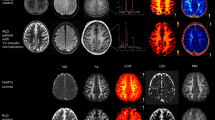Abstract
MRI in two children with moya-moya demonstrated low signal on T2-weighted images in the acute and subacute phases of ischaemia. Gradient-echo sequences, more sensitive to magnetic susceptibility, demonstrated these abnormalities better. Signal loss, due to temporary accumulation of iron, decreases progressively and disappears in the chronic stage of the disease. Diffusion-weighted MRI allows early detection of ischaemic lesions and can be used to monitor progressive spreading of the lesions. Magnetisation transfer maps provide sharp contrast, useful for demonstrating cortical atrophy.
Similar content being viewed by others
Author information
Authors and Affiliations
Additional information
Received: 14 August 1997 Accepted: 22 September 1997
Rights and permissions
About this article
Cite this article
Chabbert, V., Ranjeva, J., Sevely, A. et al. Diffusion- and magnetisation transfer-weighted MRI in childhood moya-moya. Neuroradiology 40, 267–271 (1998). https://doi.org/10.1007/s002340050583
Issue Date:
DOI: https://doi.org/10.1007/s002340050583




